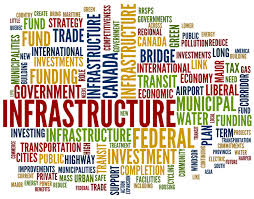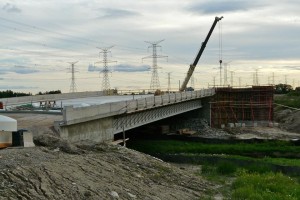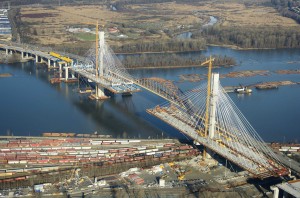
Canada’s infrastructure investment not meeting needs: CCA
By Michael Atkinson, President, Canadian Construction Association
Construction Infrastructure Canadian Construction Association CCA construction infrastructure Liberal government Michael Atkinson public policy For over 20 years the Canadian Construction Association (CCA) in collaboration and partnership with many other regional and national stakeholders has been pursuing changes in federal public policy to help modernize our aging infrastructure. Why? Because it is imperative that the general public become educated about the state of Canada’s deteriorating infrastructure and its impact on our economy and by extension our collective quality of life.
For over 20 years the Canadian Construction Association (CCA) in collaboration and partnership with many other regional and national stakeholders has been pursuing changes in federal public policy to help modernize our aging infrastructure. Why? Because it is imperative that the general public become educated about the state of Canada’s deteriorating infrastructure and its impact on our economy and by extension our collective quality of life.
A modern and efficient core infrastructure – road, rail, air, marine – is fundamental to Canada’s long-term prosperity in an ever-more competitive global economy.
There is precious little we produce in Canada today that cannot be sourced from developing countries many of which with lower wages, lower environmental standards and larger populations. As such, our export advantage is intrinsically linked to our nation’s infrastructure which enables us to move Canadian products to our global customers efficiently and in a timely manner.
However, as the wheat surge of a few years ago demonstrated, much of this infrastructure capacity is under increasing strain. Simply put, investments in our infrastructure have not kept pace with global demand for Canadian products.
Chokepoints have emerged in many places causing Canada to lose out on billions of dollars in lost opportunities and investment. With interest rates at record lows, now is the perfect time for governments to double down on their investments in trade-enabling infrastructure that Canada will need to support our export economy. Not only will this provide much needed stimulus, but it will ensure that as global demand increases for Canadian goods and services, their movement to markets will not be impeded by transportation delays caused by inadequate infrastructure.
New Liberal Infrastructure Priorities
 In October, Canada’s new Liberal government pledged to double current federal investments in infrastructure. This commitment was reiterated in the December 4, 2015, Speech from the Throne. What this means was made clear in the Prime Minister’s mandate letter to Minister Sohi, Canada’s new Minister of Infrastructure and Communities. Click here to read the entire letter.
In October, Canada’s new Liberal government pledged to double current federal investments in infrastructure. This commitment was reiterated in the December 4, 2015, Speech from the Throne. What this means was made clear in the Prime Minister’s mandate letter to Minister Sohi, Canada’s new Minister of Infrastructure and Communities. Click here to read the entire letter.
The Prime Minister’s letter outlines the key infrastructure priorities:
- Develop a 10-year plan to deliver significant new funding to provinces, territories and municipalities. This plan should ensure both immediate increased investments in infrastructure and long-term, predictable funding should support provincial, territorial and municipal priorities, improve access to, and governance of, existing infrastructure programs, increase data collection capacity and promote better asset management of infrastructure in Canada. The plan should focus on:
- public transit;
- social infrastructure, including affordable housing, seniors’ facilities, early learning and child care, and cultural and recreational infrastructure;
- green infrastructure, including investments in local water and wastewater facilities clean energy, climate resilient infrastructure like flood mitigation systems, and infrastructure to protect against change weather, and
- making changes to the Building Canada Fund so that it is more transparent, and approval processes are sped up, which would include removing the P3 screen for projects. It should also be more focussed on strategic and trade enabling infrastructure priorities, including roads, bridges, transportation corridors, ports, and border gateways.
The letter also requested that, “any unspent infrastructure funds are automatically transferred to municipalities through a temporary top-up of the Gas Tax Fund.”
The new minister was also asked by the Prime Minister to:
Work with the Minister of Finance to establish the Canada Infrastructure Bank to provide low-cost financing (including loan guarantees) for new municipal infrastructure projects in our priority investment areas.
These are critical commitments.
Public Policy must support Infrastructure

A modern and efficient core infrastructure – road, rail, air, marine – is fundamental to Canada’s long-term prosperity in an ever-more competitive global economy.
In 2012, the CCA in partnership with the Federation of Canadian Municipalities, the Canadian Society for Civil Engineering and the Canadian Public Works Association released the first Canadian Infrastructure Report Card. The goal of the report card was to provide credible and independently verified information on the state of the assets under their management. The report disclosed that core infrastructure asset management across Canada was poor and that their replacement costs were $172 billion, roughly $50 billion higher than previous estimates.
To supplement these efforts, CCA also commissioned two reports from the Canada West Foundation on the subject of infrastructure.
The first, “At the Intersection: The Case for Sustained and Strategic Public Infrastructure Investment” from 2012, was very well received in Ottawa and helped shape government thinking about the strong link between infrastructure investments and improvements to economic productivity.
The second report, “Building on Advantage: Improving Canada’s Trade Infrastructure” from 2014, spoke directly to the adequacy of Canada’s trade-enabling infrastructure. Specifically, the report found that underinvestment in our trade-enabling infrastructure assets negatively impacted the country’s ability to be a timely and reliable trading partner.
In November 2015 at the Canada 2020 conference held in Ottawa, CCA released the third report it commissioned on infrastructure. “From the Ground Up: The Role of Local Government in Building Canada’s Economic Infrastructure Network“, was authored by the Mowat Centre of Toronto and focused specifically on ways that allow for a greater role for municipalities in the identification and prioritization of investments with the provincial and federal governments in trade-enabling infrastructure.
As a result of our collective efforts and the partnership, we have developed a public policy environment that supports investments in infrastructure as a national imperative. Now, however, is not the time to be complaisant. We must continue to press with the public and all governments, the national economic and social best interests associated with investing public program dollars to support long-term economic growth.
Success in this important area of public policy advocacy will result in a modern and efficient core infrastructure, which is critical to our long-term prosperity and global competitiveness, enabling prosperity and quality of life for all Canadians.






